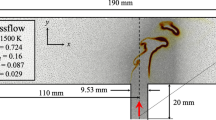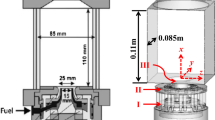Abstract
Large-Eddy Simulation (LES) results in combination with first-order Conditional Moment Closure (CMC) are presented for a hydrogen jet, diluted with nitrogen, issued into a turbulent co-flowing hot air stream. The fuel mixes with the co-flow air, ignites and forms a lifted-like flame. Global trends in the experimental observations are in general well reproduced: the auto-ignition length decreases with increase in co-flow temperature and increases with increase in co-flow velocity. In the experiments, the co-flow temperature was varied, so that different auto-ignition regimes, including low Damköhler number situations, were obtained (no ignition, random spots, flashback and lifted flame). All regimes are recovered in the simulations. Auto-ignition is found to be the stabilizing mechanism. The impact of different detailed chemistry mechanisms on the auto-ignition predictions is discussed. With increasing air temperature, the differences between the mechanisms considered diminish. The evolution of temperature, H2O, H, HO2 and OH from inert to burning conditions is discussed in mixture fraction space.
Similar content being viewed by others
References
Mastorakos, E.: Ignition of turbulent non-premixed flames. Prog. Energy Combust. Sci. 35, 57–97 (2009)
Klimenko, A.Y., Bilger, R.W.: Conditional moment closure for turbulent combustion. Prog. Energy Combust. Sci. 25, 595–687 (1999)
Pope, S.B.: PDF methods for turbulent reactive flows. Prog. Energy Combust Sci 11, 119–192 (1985)
Di Mare, F., Jones, W.P., Menzies, K.R.: Large eddy simulation of a model gas turbine combustor. Combust. Flame 137, 278–294 (2004)
Pitsch, H., Steiner, H.: Large-eddy simulation of a turbulent piloted methane/air diffusion flame (Sandia flame D). Phys. Fluids 12, 2541–2554 (2000)
Ihme, M., See, C.S.: Prediction of auto-ignition in a lifted methane/air flames using an unsteady flamelet/progress variable model. Combust. Flame 157, 1850–1862 (2010)
Ramaekers, W.J.S., van Oijen, J.A., de Goey, L.P.H.: A priori testing of flamelet generated manifolds for turbulent partially premixed methane/air flames. Flow Turbl. Combust. 84, 439–458 (2010)
Cabra, R., Myhrvold, T., Chen, J.Y., Dibble, R.W., Karpetis, A.N., Barlow, R.S.: Simultaneous laser Raman-Rayleigh-Lif measurements and numerical modeling results of a lifted turbulent H2/N2 jet flame in a vitiated coflow. Proc. Combust. Inst. 29, 1881–1888 (2002)
Markides, C.N., Mastorakos, E.: An experimental study of hydrogen auto-ignition in a turbulent co-flow of heated air. Proc. Combust. Inst. 30, 883–891 (2005)
Gordon, R.L., Masri, A.R., Pope, S.B., Goldin, G.M.: A numerical study of auto-ignition in turbulent lifted flames issuing into vitiated co-flow. Combust. Theory Model. 11, 351–376 (2007)
Triantafyllidis, A., Mastorakos, E.: Implementation issues of the conditional moment closure model in large eddy simulations. Flow Turbul. Combust. 84, 481–512 (2010)
Triantafyllidis, A., Mastorakos, E., Eggels, R.L.G.M.: Large eddy simulations of forced ignition of a non-premixed bluff-body methane flame with conditional moment closure. Combust. Flame 156, 2328–2345 (2009)
Stanković, I., Triantafyllidis, A., Mastorakos, E., Lacor, C., Merci, B.: Simulation of hydrogen auto-ignition in a turbulent co-flow of heated air with LES and CMC approach. Flow Turb. Combust. 86, 689–710 (2011)
Gordon, R.L., Masri, A.R., Mastorakos, E.: Heat release rate as represented by [OH]x[CH2O] and its role in autoignition. Combust. Theory Model. 13, 645–670 (2009)
Gordon, R.L., Masri, A.R., Mastorakos, E.: Simultaneous Rayleigh temperature, OH- and CH2O-LIF imaging of methane jets in a vitiated coflow. Combust. Flame 155, 181–195 (2008)
Jones, W.P., Navarro-Martinez, S.: Study of hydrogen auto-ignition in a turbulent air co-flow using a large eddy simulation approach. Comput. Fluids 37, 802–808 (2008)
Jones, W.P., Navarro-Martinez, S., Rohl, O.: Large eddy simulation of hydrogen auto-ignition with a probability density function method. Proc. Combust. Inst. 31, 1765–1771 (2007)
Galpin, J., Angelberger, C., Naudin, A., Vervisch, L.: Large-eddy simulation of H2-air auto-ignition using tabulated detailed chemistry. J. Turbul. 9, 1–21 (2008)
Patwardhan, S.S., Lakshmisha, K.N.: Auto-ignition of turbulent hydrogen jet in a co-flow of heated air. Int. J. Hydrogen Energy 33, 7265–7273 (2008)
Navarro-Martinez, S., Kronenburg, A.: Flame stabilization mechanisms in lifted flames. Flow Turbl. Combust. 87, 377–406 (2011)
Stanković, I., Merci, B.: Analysis of auto-ignition of heated hydrogen/air mixtures with different detailed reaction mechanisms. Combust. Theory Model. 15, 409–436 (2011)
Li, J., Zhao, Z., Kazakov, A., Dryer, F.L.: An updated comprehensive kinetic model of hydrogen combustion. Inter. J. Chem. Kinet. 36, 566–575 (2004)
Mueller, M.A., Kim, T.J., Yetter, R.A., Dryer, F.L.: Flow reactor studies and kinetic modeling of the H2/O2 reaction. Inter. J. Chem. Kinet. 31, 113–125 (1999)
Yetter, R.A., Dryer, F.L., Rabitz, H.: A comprehensive reaction-mechanism for carbon-monoxide hydrogen oxygen kinetics. Combust. Sci. Technol. 79, 97–128 (1991)
O’Conaire, M., Curran, H.J., Simmie, J.M., Pitz, W.J., Westbrook, C.K.: A comprehensive modeling study of hydrogen oxidation. Inter. J. Chem. Kinet. 36, 603–622 (2004)
Konnov, A.A.: Remaining uncertainties in the kinetic mechanism of hydrogen combustion. Combust. Flame 152, 507–528 (2008)
Cao, R.R., Pope, S.B., Masri, A.R.: Turbulent lifted flames in a vitiated co-flow investigated using joint PDF calculations. Combust. Flame 142, 438–453 (2005)
Masri, A.R., Cao, R., Pope, S.B., Goldin, G.M.: PDF calculations of turbulent lifted flames of H2/N2 fuel issuing into a vitiated co-flow. Combust. Theory Model. 8, 1–22 (2004)
Gkagkas, K., Lindstedt, R.P.: The impact of reduced chemistry on auto-ignition of H2 in turbulent flows. Combust. Theory Model. 13, 607–643 (2009)
Pope, S.B.: Turbulent Flows. Cambridge University Press, Cambridge (2000)
Smagorinsky, J.: General circulation experiments with the primitive equations. Mon. Weather Rev. 91, 99–164 (1963)
Pierce, C.D., Moin, P.: A dynamic model for subgrid-scale variance and dissipation rate of a conserved scalar. Phys. Fluids 10, 3041–3044 (1998)
Girimaji, S.S., Zhou, Y.: Analysis and modeling of subgrid scalar mixing using numerical data. Phys. Fluids 8, 1224–1236 (1996)
Navarro-Martinez, S., Kronenburg, A., Di Mare, F.: Conditional moment closure for large eddy simulations. Flow Turbul. Combust. 75, 245–274 (2005)
Kim, S.H., Pitsch, H.: Mixing characteristics and structure of a turbulent jet diffusion flame stabilized on a bluff-body. Phys. Fluids 18, 075103 (2006)
O’Brien, E.E., Jiang, T.L.: The conditional dissipation rate of an initially binary scalar in homogeneous turbulence. Phys. Fluids 3, 3121–3123 (1991)
Broeckhoven, T.: LES of turbulent combustion: numerical study and applications. PhD thesis, VUB - Department of Mechanical engineering (2007)
De Paola, G., Kim, I.S., Mastorakos, E.: Second-order conditional moment closure simulations of autoignition of an n-heptane plume in a turbulent co-flow of heated air. Flow Turbl. Combust. 82, 455–475 (2009)
Klein, M., Sadiki, A., Janicka, J.: A digital filter based generation of inflow data for spatially developing direct numerical or large eddy simulations. J. Comput. Phys. 186, 652–665 (2003)
Mastorakos, E., Baritaud, T.A., Poinsot, T.J.: Numerical simulations of auto-ignition in turbulent mixing flows. Combust. Flame 109, 198–233 (1997)
Bilger, R.W., Starner, S.H., Kee, R.J.: On reduced mechanisms for methane-air combustion in nonpremixed flames. Combust. Flame 80, 135–149 (1990)
Wu, Z., Starner, S.H., Bilger, R.W.: Lift-off heights of turbulent H2/N2 jet flames in a vitiated co-flow. In: Proceedings of the 2003 Australian Symposium on Combustion and the Eighth Australian Flame Days. The Combustion Institute (2003)
Jones, W.P., Navarro-Martinez, S.: Numerical study of n-heptane auto-ignition using LES-PDF methods. Flow Turbl. Combust. 83, 407–423 (2009)
Markides, C.N., Mastorakos, E.: Experimental investigation of the effects of turbulence and mixing on autoignition chemistry. Flow Turbl. Combust. 86, 585–608 (2011)
Lee, C.W., Mastorakos, E.: Transported scalar PDF calculations of autoignition of a hydrogen jet in a heated turbulent co-flow. Combust. Theory Model. 12, 1153-1178 (2008)
Markides, C.N., De Paola, G., Mastorakos, E.: Measurements and simulations of mixing and auto-ignition of an n-heptane plume in a turbulent flow of heated air. Exp. Therm. Fluid Sci. 31, 393–401 (2007)
Author information
Authors and Affiliations
Corresponding author
Rights and permissions
About this article
Cite this article
Stanković, I., Mastorakos, E. & Merci, B. LES-CMC Simulations of Different Auto-ignition Regimes of Hydrogen in a Hot Turbulent Air Co-flow. Flow Turbulence Combust 90, 583–604 (2013). https://doi.org/10.1007/s10494-013-9443-2
Received:
Accepted:
Published:
Issue Date:
DOI: https://doi.org/10.1007/s10494-013-9443-2




